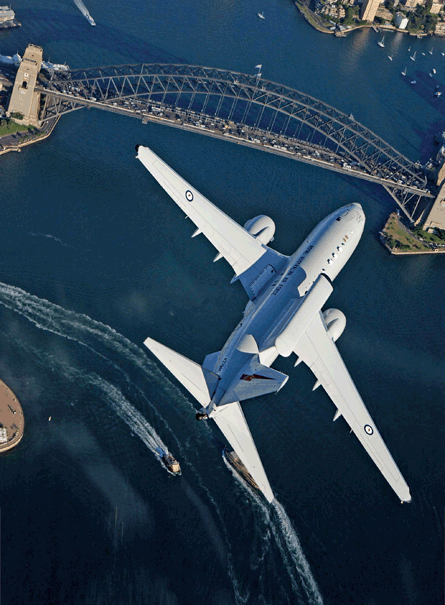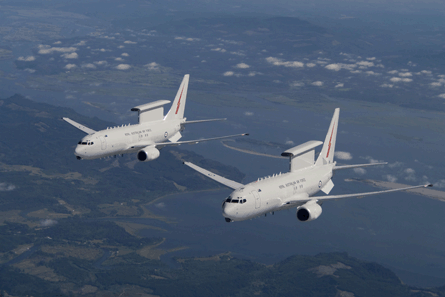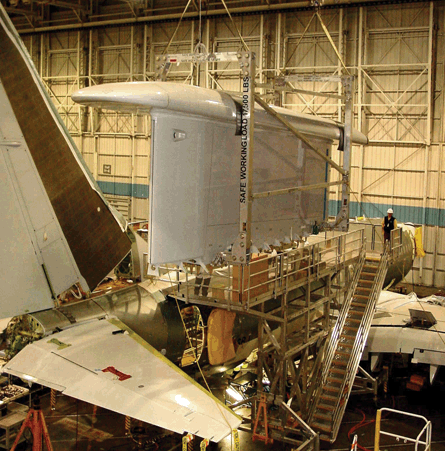Boeing and Northrop Grumman agreed on a concept in 1996 for packaging a popular aircraft with a powerful new radar. Boeing would modify its best-selling 737 to carry Northrop's multi-role electronically scanned array (MESA), a new kind of airborne radar conceived at the height of the Cold War. The combination would spark a dormant market for airborne early warning even as it profoundly changed the market's demand for radar performance.
Boeing has now delivered the first two 737 airborne early warning and control aircraft to the Royal Australian Air Force under Project Wedgetail, a landmark achievement in the history of airborne radar, but tarnished by a series of delays and cost overruns.
Boeing's team has persevered through setbacks that could have scuttled even less ambitious programmes, and now the 737 AEW&C sits unrivalled in the market for a jet-powered, high-altitude, airborne radar with room for 10 operators and crew.
 |
|---|
© Boeing |
MARKET RESPONSE
The market has responded to the availability of Boeing's current successor to the E-3 airborne warning and control system, the pioneer system that defined the role that the Wedgetail fleet will shortly assume.
In addition to the six aircraft ordered by the RAAF, the Turkish air force's Peace Eagle contract adds four aircraft and the more recent Peace Eye deal for South Korea's E-X contract adds four more.
But the 737 AEW&C's sales experience in the decade ahead is likely to determine how history judges the success of Boeing and Northrop's concept.
The United Arab Emirates is becoming better acquainted with the capabilities of an advanced airborne radar system. Boeing's 737-based offering faces a formidable challenge from Northrop's E-2D Advanced Hawkeye in Abu Dhabi, where mission radius is perhaps less demanding than in Australia.
An even more promising market for the 737 AEW&C is shaping up in India, which has already agreed to purchase the 737-based Boeing P-8I. India is expected to release a request for proposals this year, with the navy and air force queuing for Wedgetail-like capability.
How the 737 AEW&C competes for the ultimate prize - the US Air Force E-3 AWACS replacement - remains at least another decade away. Such a contract will almost certainly feature a MESA-like array, but whether on the 737 or a larger platform is still open for debate.
 |
|---|
© BoeingThe 737 is big enough for 14 operators who can make on-the-spot tactical decisions |
Meanwhile, there is no doubt that the 737 AEW&C defines the new standard in its market space. As its software matures and its deficiencies are resolved, the vision launched by Boeing and Northrop will be realised.
"As we move forward with Australia I believe we're going to see Wedgetail being the centrepiece of how the [RAAF] fights in the future. And we're going to see for 30, 40, 50 years continued growth in that capability," says Tony Parasida, Boeing vice-president and general manger of airborne anti-submarine warfare and intelligence surveillance and reconnaissance programmes.
The decision to install the MESA radar on the 737 by now seems obvious, but it may not have looked so easy in 1996. It would be the first time Boeing adapted its franchise airliner - the best-selling commercial aircraft in history - for a purely military use. The 737 is now the platform for Boeing's anti-submarine warfare and maritime patrol P-8A/I Poseidon, and is proposed to succeed the US Navy's Lockheed EP-3.
"With the 737-based solution you have sensor operators in the back of the airplane that can make command and control decisions. You can't do that in a small airplane," Parasida says. "The 737 is huge. You can put up to 14 operators in the back of the airplane. You can make tactical decisions right there. So that I think is the key feature."
With a maximum take-off weight of 77,565kg (170,850lb), the 737-700 increased gross weight offered a relatively inexpensive platform still large enough to carry the MESA antenna, which measures 10.7m (35ft) long and 4.6m tall, as well as the ability to store enough power to operate the radar and enough fuel to provide 10h endurance.
To integrate the 3t antenna, Boeing would have to make its most substantial airframe modifications to Section 46, the stretch of the 737 fuselage that lies between the trailing edge of the wing and the leading tip of the dorsal fin fearing.
Boeing details the changes: "Section 46 of the fuselage is substantially reinforced in the upper lobe above the floor line. The original Section 46 upper lobe is removed at existing splice joints and replaced with a heavily reinforced upper lobe section provided by Spirit AeroSystems. The MESA radar antenna mates with 11 pairs of fittings at 11 consecutive fuselage frames in Section 46. The original Section 46 frames are replaced with heavy machined frames to support the MESA flight loads."
Compensating for the MESA antenna's aerodynamic changes, Boeing has attached three-spar ventral fins on each side of the lower fuselage.
The cabin interior is divided into three sections. In the forward cabin, two communication cabinets - the first containing intercom and terrestrial links, and the second managing UHF and satellite links - stand nestled between the cockpit and crew stations. Five mission consoles, each seating two mission operators, consume much of the forward cabin. Another cabinet houses the mission data processor. An eight-seat crew rest area fills the space between the forward and aft cabins.
 |
|---|
© Flightglobal/Joe PicarellaClick on cutaway for full size version |
The aft cabin - Section 46 - structurally supports the antenna, and stores the radar electronics, as well as a sophisticated cooling system. The ceiling of the cabin is filled with the transmit/receive modules that are used to steer the beam emitted by the MESA antenna.
SYSTEM HEART
The heart of the 737 AEW&C system is, of course, the MESA array. There are several different ways to build an airborne radar to provide 360° coverage.
The E-3, for example, has a Northrop APY-2 radar that steers the antenna with a rotodome that rotates around the aircraft at the rate of 6RPM. While a simple and effective approach, target tracks can be revisited only as fast as the antenna can rotate.
A second approach to achieve 360° coverage is to package three electronically scanned arrays into a triangle-shaped radome, dispensing with the rotodome. Israel's Elta Systems used this design for India's Il-76 AWACS system, which was first delivered in May 2009. A possible drawback of this system is the extra weight and complexity required to install the three arrays atop the aircraft.
For the MESA antenna, Northrop hoped to achieve the 360° coverage requirement without the need for a rotodome or three array panels. Instead, the antenna module includes two back-to-back arrays, each scanning a 120° field of view, and an endfire mounted at the top looking 60° front or aft.
This configuration means the MESA can point the beam nearly simultaneously in any direction. The design also allows the radar to change how quickly the beam can be moved to revisit the target by reprioritising where the radar's power is focused.
By comparison, an E-3-like rotating array only scans a target once as it revolves every 10s. Using endfire technology, the MESA can take power focused in one direction and refocus it into space if tracking priorities change. The more concentrated beam can also search deeper into the airspace, or detect smaller or perhaps stealthy targets within normal ranges.
The effect of the MESA approach is the ability to put a beam on a target of interest anywhere in the airspace, and maintain the track to stay aware of the target's activity. Boeing calls this capability "beam on demand", and it expresses the heart of MESA technology's revolutionary approach to airborne radar.
Project Wedgetail will enter operational service three years late and at an extra cost to Boeing greater than $1 billion, which the company accepted as a write-down. Despite doubts raised by the unexpected technical challenges, a three-week exercise conducted from late April to mid-May helped to restore confidence in the 737's capabilities.
 |
|---|
© BoeingThe Royal Australian Air Force finally received its first two Project Wedgetail 737s in late 2009 |
The exercise, named Arnhem Thunder, allowed RAAF crews to fly the Wedgetail system in both offensive and defensive counter-air missions. The system flew six sorties in the three-week period, with multiple fighter engagements performed during each sortie. The results, although classified, suitably impressed the RAAF, with Air Marshal Mark Binskin describing Arnhem Thunder as a resounding success as a test of the Wedgetail's operational performance.
Binskin's remarks, made at the Dubai air show in November, contrasted sharply with earlier, more measured statements from Australia's military and political leadership.
As late as April 2009, Australian military officials acknowledged the programme still faced major issues. Testifying before the joint standing committee on foreign affairs, defence and trade, Warren King, general manager for programmes for Australia's Defence Material Organisation, confirmed problems remained.
"There is no doubt about the fact that the programme remains challenged," said King, according to a transcript of the hearing posted online by the Australian parliament.
King described two fundamental areas that were still "challenged", including "the radar performance in particular modes, which is important to us, and the electronic surveillance measure system".
The issues with the radar appear to have attracted the most concern and caused the DMO to last year commission a third-party opinion from the Massachusetts Institute of Technology's Lincoln Laboratory, which specialises in radar technology. Tellingly, Australian officials wanted MIT's scientists to study whether the Wedgetail radar technology could be improved to meet or surpass the original requirement.
"If [the radar] does not work to full specification at the moment will it over time grow into being everything we expected?" asked King, describing the DMO's brief for the Lincoln study.
According to Boeing and Australian programme officials, the Lincoln report briefed privately in June confirms that the radar performance of the MESA radar can meet the Wedgetail programme's needs.
"Our friends at the DMO were somewhat concerned about the system's growth capability," said Boeing's Parasida at the Paris air show. "It was great to see the MIT lab assessment say 'yes, it really does have that fundamental architecture, [which] is sound and the system does have growth capability," Parasida said.
Australian government officials also agree that the Wedgetail technology is fundamentally sound.
RAAF Air Marshal Mark Binskin, addressing the Defense International Air Chiefs conference in Dubai in November, described Wedgetail as a dramatic improvement for maritime and coastal surveillance. However, Binksin also said after his briefing that Australia would not receive a fully operational Wedgetail until late 2010.
Moreover, Australian government officials have made it clear that the aircraft's surveillance systems would not be fully capable of contractually required performance levels.
In his parliamentary testimony last April, King hinted at the key technical issues facing the programme's engineers.
"I should say that there are many other features of the aircraft that are all working or close to working - the link systems, the [identification friendly or foe] and the radar in non-pulse Doppler mode," said King.
Perhaps significantly, King's description omitted the radar in pulse-Doppler mode from the list of features that are close to meeting Australia's requirements. Pulse-Doppler radar is used to distinguish targets moving amid background clutter.
This issue was clarified in the same hearing by the parliamentary committee. Air Vice Marshal Colin Thorne said the fundamental problem with the Wedgetail radar related to such a problem. "It is a ground clutter issue," said Thorne. "Radar like this looks down on the ground and everything that is on the ground and is a legitimate target for a radar like that.
"It comes down to the software to be able to sort real targets or air targets above the ground from the ground behind it," Thorne continued. "That is fundamentally the issue with the radar."
RANGE CONCERN
Another lingering concern has been focused on the Wedgetail radar's range, which Boeing advertises as greater than 610km (330nm) for targets at 10,000ft and as greater than 390km for targets at 500ft.
"The key issue for us is getting the detection range and being able to confirm that across the operations of the radar, so that is a significant issue," Air Vice Marshal Chris Deeble told the same parliamentary committee in 2008.
 |
|---|
© Northrop GrummanThe MESA radar is at the heart of the Wedgetail |
Australian officials believe the root of the problems is not a fundamental flaw in Northrop's technical approach. In the early phases of the Wedgetail contract competition, the RAAF performed due diligence at the radar development site near Baltimore, Maryland.
In his testimony last April, Thorne recalled that the radar performed as expected in the ground environment.
"One of the issues that you do have with that kind of system with an airborne radar, particularly one of that size, is that until you marry the radar to the aircraft, which is naturally late in the development cycle, you cannot retire all that risk elements," Thorne said.
"What has happened is that as we have moved into that development and finally to the stage where we can marry a radar to an aircraft and get it airborne it has exposed some of the issues," he said.
Source: Flight International



















